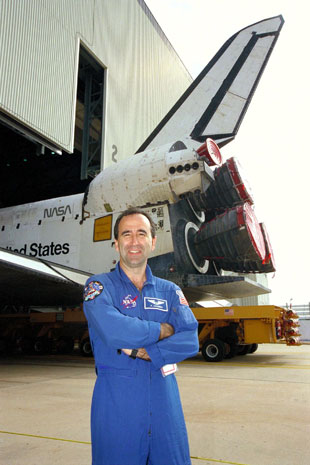October 5, 2009 — Fernando "Frank" Caldeiro, a NASA astronaut and the first person of Argentinean descent to train for a space flight, died on Saturday after a two and a half year battle with brain cancer. He was 51.
First hired by NASA in 1991 as an expert in cryogenics and propulsion systems for the Kennedy Space Center's safety and mission assurance office in Florida, he took part in 52 space shuttle launches before being chosen as an astronaut candidate in 1996.
"He and I came down [to Houston] in 1996 together, and actually was one of the first people I met when I got down here," recalled fellow 1996 astronaut group member Rex Walheim in an phone interview with collectSPACE.com. "He was a great guy."
"The thing that struck me, especially through the time he was diagnosed with cancer, his determination and his upbeat spirit was really inspirational," said Walheim. "I saw him a couple of days after he had had surgery and he was up and around, he was sitting up and talking and his upbeat attitude never wavered. It was amazing how he didn't let it get him down."
As a member of NASA's 16th class of "ascans," dubbed "The Sardines" because at 44 candidates they were the largest group of astronauts to be chosen to date, Caldeiro went through basic training alongside Walheim, Peggy Whitson, the current chief of the Astronaut Office, and Jeff Williams, who arrived aboard the International Space Station (ISS) last week.
Caldeiro however, would never be assigned to a mission.
In 2006, he told the Orlando Sentinel, "Flying in space, to me, has become more like, well, you know, you can't chase something so much that you run it over. You can be obsessed by it and be miserable or you can say, 'Well, this is an opportunity; I'm first in line in front of 350-million other people.'"
Embracing a career with NASA that followed the latter path, Caldeiro served in technical support roles, first as the lead astronaut for the station's life support systems and its European-built components, reviewing the design and manufacture of the U.S. "Harmony" Node 2 and European Space Agency (ESA) Columbus modules, as well as the yet-to-be-launched Cupola robotics viewing port and the space shuttle-lofted cargo carriers, the Multi Purpose Logistics Modules (MPLM).
From June 2005 to December 2006, Caldeiro served as the lead astronaut in charge of shuttle software testing at the Johnson Space Center's Shuttle Avionics Integration Laboratory, testing in-flight maintenance procedures, prior to being reassigned to Houston's nearby Ellington Field to direct the high-altitude atmospheric research experiment program carried onboard NASA's WB-57 aircraft.
He was still serving in that role when he passed away.
"Frank was a valued member of the astronaut corps and the Flight Crew Operations team," said fellow astronaut Brent Jett, the director of NASA's Flight Crew Operations. "He provided a wealth of experience and made significant contributions to the success of both the WB-57 project and the space shuttle program. He will be missed by all those who knew him at NASA. Our hearts go out to his family."

| Caldeiro poses in front of shuttle Discovery in 1998. (NASA) |
Born June 12, 1958, in Buenos Aires, Argentina, Caldeiro immigrated to the United States at age 16 not speaking a word of English. First settling in Flushing, New York, he went on to earn an associate degree in applied science in aerospace technology from the State University of New York at Farmingdale, followed by a bachelor of science degree in mechanical engineering from the University of Arizona in 1978 and 1984 respectively.
Eleven years later, he completed his master of science degree in engineering management from the University of Central Florida.
Before working for NASA, Caldeiro was hired by Rockwell International, working on the checkout and delivery of all 100 B-1B Bombers to the U.S. Air Force. In 1988, he reported to Kennedy Space Center as a Rockwell space shuttle main propulsion system specialist responsible for the ground processing and launch of shuttle Discovery.
In 2002, he was named National Hispanic Scientist of the Year by the Museum of Science and Industry in Tampa, Florida. That same year, he was appointed by President George W. Bush to serve on the Advisory Commission on Educational Excellence for Hispanic Americans under the "No Child Left Behind" Act.
A member of the Experimental Aircraft Association and the Aircraft Owners and Pilots Association, Caldeiro was known to enjoy flying and racing his own Rutan Long Ez experimental aircraft, in which he logged over 500 hours.
"He loved to fly," shared Walheim. "He just loved flying around in that thing."
"He was also very devoted to his family," Walheim said.
He is survived by his wife, the former Donna Marie Emero of Huntington Beach, California, and two daughters, Annie and Michelle.
This article was updated on October 7 with comments by astronaut Rex Walheim. 